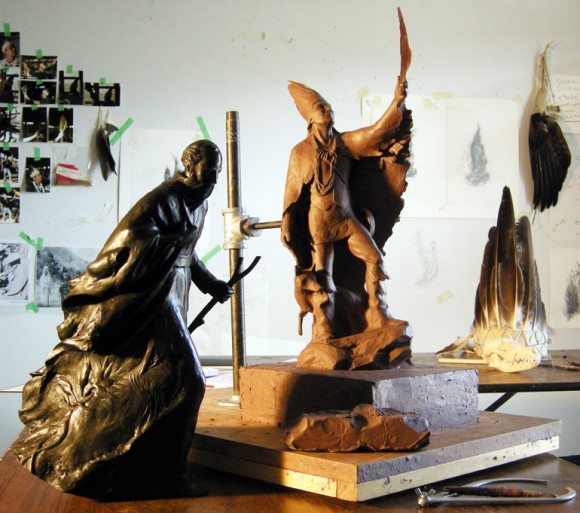
Artist Crystal Przybille’s renderings of statues representing Father Pandosy and Chief S?knc?u will be part of the discussion Friday, May 8 at the AlterKnowledge Discussion Series. Photo credit: Crystal Przybille.
Discussion series looks at sculptures of Father Pandosy and Chief S?knc?ut
What: AlterKnowledge discussion on public history and art with the Pandosy and S?knc?ut sculptures
Who: UBC students and faculty, members of the public
When: Friday, May 8, from 7 to 8:30 p.m.
Where: Alternator Centre for Contemporary Art, 421 Cawston Ave., Kelowna
Does art have a role when it comes to the public’s understanding of history and place? UBC Okanagan’s AlterKnowledge series participants will engage in a special discussion about the role that public art may have in shaping perspectives on Kelowna’s history.
“The common stories and images of Kelowna’s history tend to focus on a narrow account of Euro-Canadian settlement and development, and leave out many other experiences,” says Delacey Tedesco, a doctoral candidate in political science at the University of Victoria.
And while public art may often uphold and celebrate these narrow accounts, it can also powerfully refigure how Kelowna’s history is remembered and understood, says Tedesco.
Artist Crystal Przybille’s sculptures of two important Okanagan historical figures—French Oblate missionary Father Charles Pandosy and Chief S?knc?ut—are an example of this possibility. Przybille's life-sized bronze sculpture of Pandosy was unveiled at the Pandosy Mission historic site in 2012, commemorating the 150th anniversary of this site. In Kelowna's public memory, the Pandosy sculpture serves to mark the beginning of Euro-Canadian settlement in the Okanagan, on the traditional and unceded territory of the Syilx people.
However, through a commission by Westbank First Nation, Przybille is working on a second bronze sculpture—this one of Chief S?knc?ut—which will offer an important companion piece and a permanent public reminder of Syilx presence and perspectives on this shared history.
“The process of informing myself to create the Pandosy and S?knc?ut sculptures has been an unexpectedly profound, and progressively ‘un-settling’ journey,” says Przybille. “It has led me to important understandings regarding the dynamics of settler and Indigenous histories in the Okanagan, and how these histories are perpetuated or suppressed in public memory.”
Students, faculty, and members of the public are invited to come share their views with Przybille and Tedesco about art and the role these sculptures may play in rethinking Kelowna's public history. This is the final AlterKnowledge discussion event for this academic year. The event is free, open to the public, and takes place at the Alternator Centre for Contemporary Art, 421 Cawston Ave., on Friday, May 8 at 7 p.m.
The AlterKnowledge Discussion series, organized by UBC Asst. Prof. Allison Hargreaves and Assoc. Prof. David Jefferess, aims to foster community-engaged knowledge-making, rather than simply providing a venue for the presentation of research to the public. There were nine events this past academic year, and the series continues to bring people together to discuss, share, and learn, and focus on critical engagements with the way colonialism continues to shape relationships and identities in both local and global contexts.
–30–
 Woman jailed for sex assault
Woman jailed for sex assault Rescued after fall into river
Rescued after fall into river Killer not happy with show
Killer not happy with show Facial recognition at border?
Facial recognition at border? PM ups attacks on Poilievre
PM ups attacks on Poilievre CRA will get the money: PM
CRA will get the money: PM Instagram fraudster jailed
Instagram fraudster jailed 11 Trump allies indicted
11 Trump allies indicted Ukraine uses new missiles
Ukraine uses new missiles BoC officials split on rate cut
BoC officials split on rate cut Big loss for Boeing
Big loss for Boeing  Metro sales edged higher
Metro sales edged higher Vees dominating Vipers
Vees dominating Vipers Warriors snakebitten in loss
Warriors snakebitten in loss Iginla off to Europe
Iginla off to Europe Coachella fined $28K
Coachella fined $28K Those are her nipples
Those are her nipples Kanye to launch porn studio
Kanye to launch porn studio




